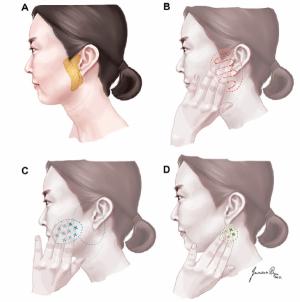Samsung Medical Center-National Cancer Center, published in the international journal BMC Cancer
Professor Hanshin Jeong “Self-examination is a shortcut to the prevention of early detection of Lee Ha-seon’s tumor”
[팜뉴스=이석훈 기자] A domestic research team proposed a self-examination method that helps early detection of parotid adenocarcinoma, one of the salivary gland cancers, and started spreading it.
It is a method of checking abnormal signs by touching the area around the ear, which is the main site of the disease, with your hand.
As it is simple enough that anyone can follow it, it is expected to help increase the early diagnosis rate.

The research team of Professor Hanshin Jeong of the Department of Otorhinolaryngology at Samsung Medical Center announced on the 15th that the research team of the National Cancer Center Head and Neck Oncology Clinic, together with Prof. Joon-Seon Ryu, published a self-examination method for Lee Hae-seon cancer in the recent issue of BMC Cancer.

First, check the area around the ear where the parotid gland is located (Figure A) with your hands to check for lumps (Figure B), and then move it from the jaw bone to the tail of the mouth and to the side of the nose (Figure C).
The space between the jaw bone and the bone behind the ear, where part of the parotid gland is present, must also be checked to ensure that there are no lumps to be touched. (Picture D)
The research team recommended, “If the lump is touched for more than two weeks as a result of self-examination, you must get a medical examination and examination by a specialist.”
Salivary gland cancer, including parotid adenocarcinoma, is a very rare type of cancer. It is known that about 1.4-2.0 people per 100,000 population.
Because of this, interest is lower than that of other cancers, but even a little late diagnosis is scary enough to be fatal.
Among salivary gland cancers, highly malignant salivary gland cancers are common in recurrence and metastasis, and are among the worst prognosis among head and neck cancers.
It is known that the 5-year survival rate is only about 50 to 60%.
The importance of early detection was once again emphasized in a study published together with Professor Hanshin Jeong’s research team devising a self-examination method.
As a result of analyzing 406 patients diagnosed with parotid gland cancer at Samsung Seoul Hospital, the research team reported that the higher the size of parotid gland tumors, the greater the rate of being diagnosed as high-malignant cancer.
According to the research team, 20.2% of cases of parotid gland cancer were diagnosed as high-malignant cancer when the size of the parotid gland was less than 2 cm, 34.4% of cases of 2-4 cm and 47.9% of cases of more than 4 cm.
Professor Jeong Han-shin said, “In the case of salivary gland cancer, the survival rate reaches 90% even if it is detected early. However, if the timing is missed, the prognosis is worse than other cancers. After that, it is important to touch the salivary gland frequently and consult a doctor as soon as possible if there are any abnormal symptoms.”
Copyright © Farm News Unauthorized reproduction and redistribution prohibited
